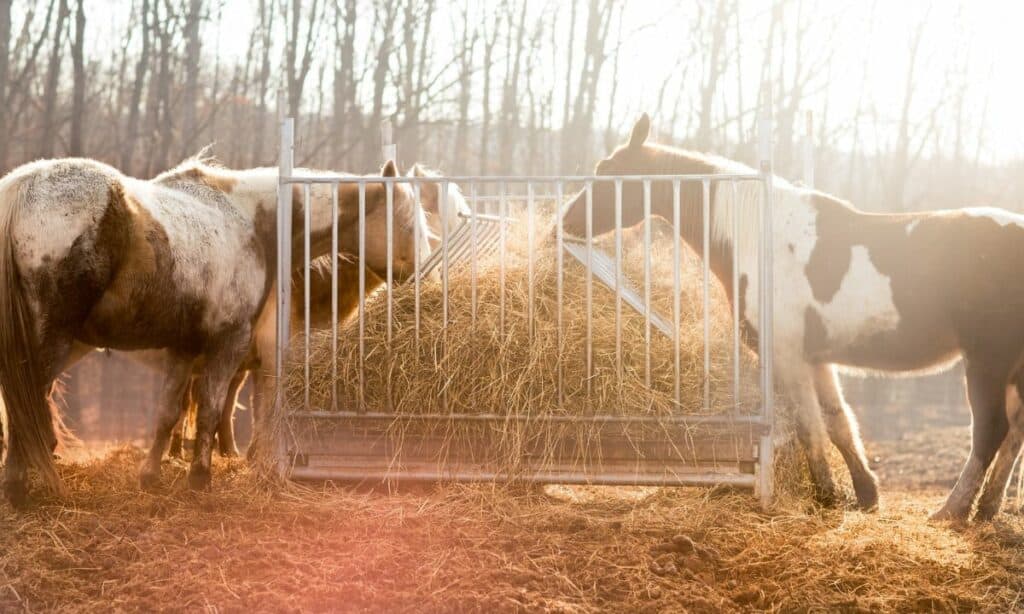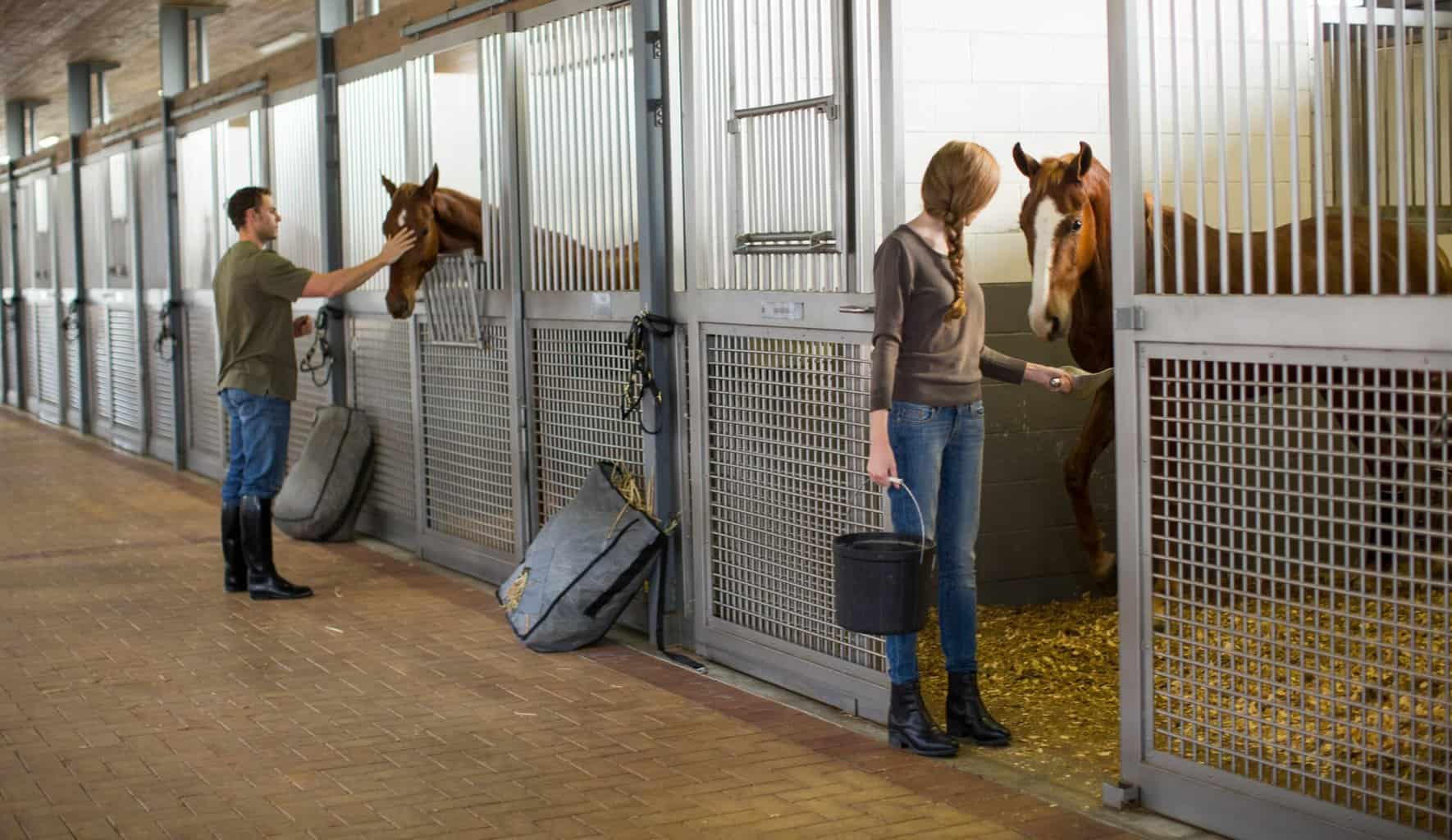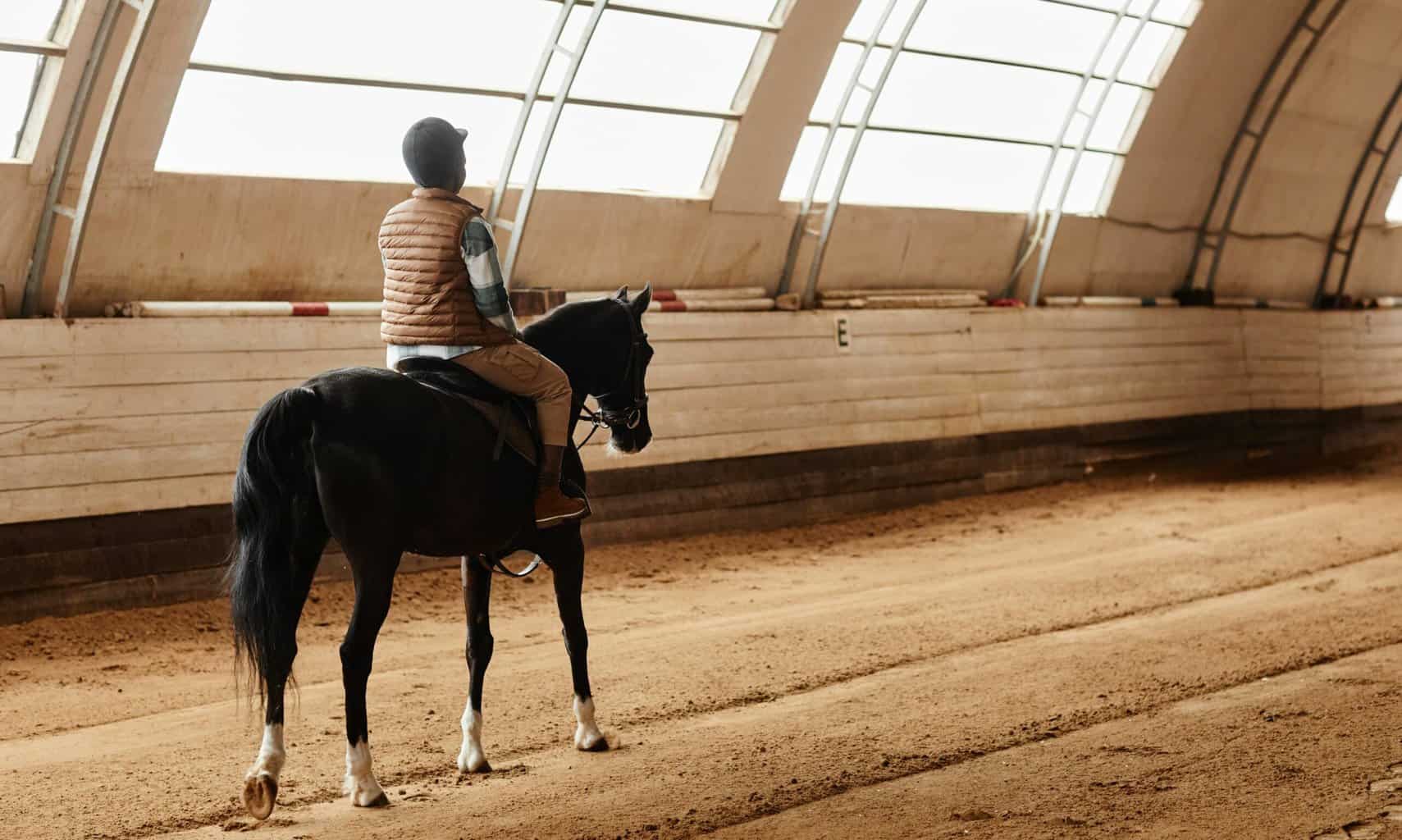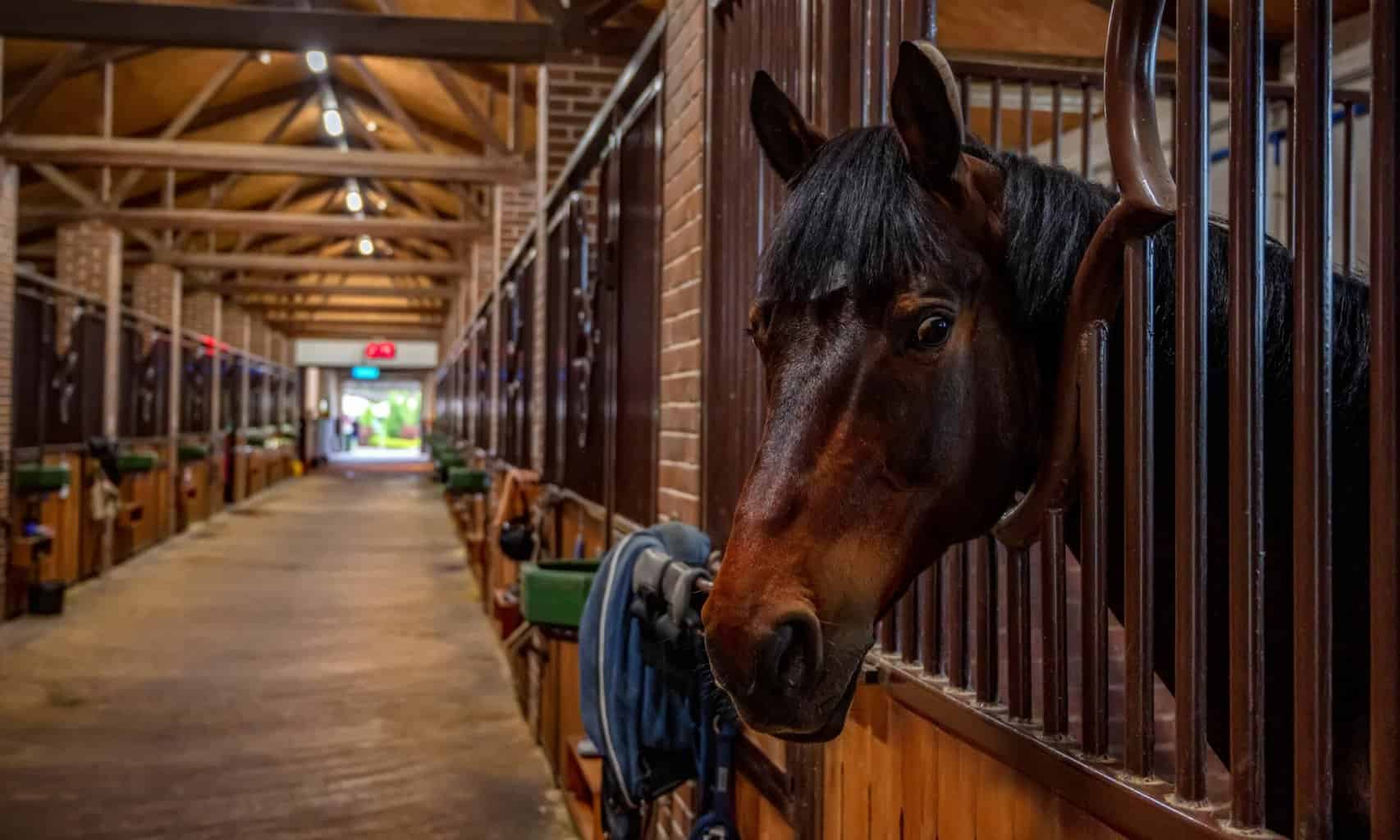- What is a Gaited Horse - October 5, 2023
- What to Look at When Getting a New Farrier - September 21, 2023
- Best Horse Feeds for Older Horses - September 21, 2023
As horse owners know, feeding their horses can cost a lot as horses seem to eat all day (and night). But just how much does a horse eat in a day?
I’ve often helped new horse owners calculate how much to feed their horses to ensure they have enough roughage, protein, and other vital nutrients. Correctly feeding your horse helps them maintain good health and the correct body weight.
Many factors weigh in when calculating how much to feed your horse daily. It’s not as simple as measuring their height and feeding them accordingly. But don’t worry; I’ve got all the information right here on how much your horse should eat in a day.
Bottom Line Up Front: How Much Does a Horse Eat?
A horse in moderate to heavy work must eat 2% of their body weight. So a horse that weighs 900-1,200 pounds needs to eat 18-24 pounds of feed in a day. Of course, this amount doesn’t fully account for the daily grazing and hay a horse requires.
Here’s a handy chart to help you decide how much to feed your horse per day:
| Horse’s Weight | Concentrate Feed (0.5%) | Hay and Grazing (1.5%) |
| Small Pony (10-13.2 hands; 300-800 pounds) | 2-4 pounds of concentrate, split into 2-3 meals | 6-16 pounds of hay |
| Medium Pony (13.3-14.2 hands; 800-950 pounds) | 4-6 pounds of concentrate, split into 2-3 meals | 16-19 pounds of hay |
| Small Horse (14.3-15.2 hands; 900-1100 pounds) | 6-8 pounds of concentrate, split into 2-4 meals | 19-22 pounds of hay |
| Large Horse (15.3-18+ hands; 1100-1200+ pounds) | 8-10 pounds of concentrate, split into 2-4 meals | 22-25 pounds of hay |
How Much Concentrate to Feed Your Horse
A horse is a trickle feeder, and since they have an exceptionally long digestive tract, they need to eat almost constantly, steadily consuming small amounts of roughage to prevent digestive issues. Concentrated feed helps add weight to a horse, providing them with the energy needed for work, but it shouldn’t be the only (or the most) feed the horse gets.
The feeding table is for an average, healthy pony or horse that does moderate work, but other factors influence how much to feed a horse. None of my five horses get fed the same amount of feed or hay.
It’s more an art than a science when feeding your horse correctly, but a few basics hold true. And while you can always feed a little less than the recommended dosage, you should never feed more than each meal’s maximum limit.
An adult horse’s limit for a complete meal of concentrated feed should never exceed four pounds. The quantity of feed has nothing to do with your horse’s appetite or level of work but rather everything to do with their stomach size.
A horse shouldn’t eat until their stomach is full. Instead, their stomach should never be more than two-thirds full. A full stomach strains against the intestines, and it can create more gas, which causes gas colic.
The number one killer of horses is colic.
Feeding your horse large quantities of sweet feed in single meals is a surefire recipe for colic. Remember to weigh your horse’s feed; don’t only work on volume.
A scoop of feed may be anything between a pound to six pounds, depending on the composition of the feed. So having a kitchen scale handy is best.
Feeding Costs per Horse
Since an average size horse in moderate work eats two meals (minimum) of three pounds per meal, you can bargain on needing 180 pounds per month to feed this horse. Most sweet feeds are available in 50-pound bag sizes, so you’d need 3.6 bags of sweet feed for a month’s rations.
The cost of this can become staggering: at roughly $50 per bag, your feed bill for concentrated sweet feed would be $180 for the month. For senior horses, this would be much higher.
Of course, some horses require less feed, while others need specialized feeds to maintain good weight. Find the middle ground of what works for your horse, what the manufacturer recommends and what your horse’s level of work is when feeding.
Hay is your next feed expense, and you can expect to pay between $3-$7 per square bale. Since a horse can easily eat a half a bale at night, they need at least 15 square bales per month, totalling a further $45-$105 per month.
Factors Influencing How Much a Horse Eats in a Day
So let’s look at the factors determining how much concentrate to feed your horse in a day. Note that some horses don’t need any concentrated feed and do well on grazing and hay (usually in winter).
Whenever someone asks me what to feed, I always go through this list with them.
Exercise
If your horse works hard, they should eat appropriately. However, if you have a “lawn-ornament” or non-ridden horse, chances are they don’t need to be fed much in addition to hay or grazing except to maintain their condition.
Horses that race, jump, perform sports such as Western games, do ranch work, or ride endurance should receive a larger meal (three to four meals) daily.
However, suppose your horse performs dressage (at the lower levels), hacks, or is a companion animal. In that case, you should look at their physical appearance and health when calculating their feed, as their weight isn’t the only or main indication of their feed requirements.
Age
Young, growing horses need to get a higher protein content feed (usually 14-16% protein-based feeds) to help their healthy development and assist them when they transition from nursing to depending on feed and grazing. However, their meals will be small, and depending on their size, they could get anything from a handful at a time to a pound or two per meal (usually two to three meals per day).
My older horses, like my mare, who is 17 and has only 70% molar contact, get fed a 14% protein meal at the maximum weight of two pounds per meal (four meals per day).
If your horse has a problem with excess weight, cut back their concentrated feeds. I do this with my older fatty pony (aka “pregnant” gelding), who doesn’t need the feed but gets a handful once daily to get some extra vitamins and joint supplements.
Some geriatric horses that have lost most of their teeth and have poor digestion may need to be on a series of daily meals that contain the maximum for their ideal weight. One such horse at our barn was Spirit, a 31-year-old pony with no more teeth and an abundance of ulcers.
We fed him four to six meals a day to keep weight on him. His main meal was 16% protein, with the additional “meals” being chopped hay soaked in diluted molasses. A senior feed containing micronized protein was a great call for him, limiting the need for chewing.
Health
In addition to the age and exercise level, a horse may need more feed on freezing days, and their health can also influence their need for feeding. A horse struggling with ulcers may need to be on a restricted diet, while a horse that’s diabetic could need to be placed on a roughage-based diet to reduce their sugar intake.
So how do you know whether your horse is ideal, overweight, or underweight?
There are many different opinions, and people often don’t understand what to look for. So here’s the guideline that most horse charities and anti-cruelty associations look at when considering whether a horse eats enough (or too little):
| Guidelines to Determine Whether a Horse Is Being Fed Enough | |
| Ribs | A horse’s ribs should be covered (preferably with muscle), and when they turn 20-35 degrees to the side, you should just lightly see the outline of their ribs. |
| Hips | The horse’s hip bones should be covered, rounding into the top of the thigh, without any serious indentations. |
| Top-Line | While older horses won’t have a top-line unless they still actively exercise, a horse’s spine shouldn’t stick out either. Note this can be a challenge with high-withered horses. |
| Belly | Some horses drop their weight down to their belly, resulting in a “grass-belly,” which makes them look skinny while increasing their weight negatively.
Exercise to build muscle is the best way to overcome this problem. Only ponies and mares are supposed to have slightly “hanging” bellies. |
| Butt | The horse’s buttocks aren’t supposed to show “poverty lines” or indented clefts that cut into the muscle from the tail to the hocks.
Muscle definition in competition horses is something else entirely. Poverty lines usually go with bare ribs and boney hips. |
But, How Much Hay Per Day?
Most people are amazed by how much hay I buy my horses per month. Even though they have good grazing, they spend 12 hours a day in their stables, and I want my horses to have free access to hay at all times.
Good quality grass hay is ideal for horses. Due to health issues, there’s no need to buy expensive hay unless your horse needs higher protein-rich hay, such as lucerne or alfalfa.
While some horse owners believe that restricting the hay intake of an overweight horse leads to hay-guzzling, any interruption of the horse’s feeding ability for long periods can cause ulcers and colic.
My golden rule? I fill two hay nets per horse for the night. I check whether hay’s still left in the nets the following day. If at least a quarter of a net is left, then I know my horse was well-fed. If the net is empty, I add a hay net the next night.
FAQs
Answer: A horse can consume 113 grams of grazing per hour when the grazing is poor quality. For a medium-quality grazing pasture, a horse can eat 225 grams, while they can forage 338 grams in an hour on excellent grazing.
Answer: Since a horse eats about 20-25 pounds of hay daily, they can consume half of a 50-pound square bale. So a horse will need 15+ bales monthly to ensure they consume their required roughage daily.
Answer: While horses can manage 20-28 days without food, if they don’t have a high energy expenditure and get enough water, they will die within two to three days of not having enough water. Yet, a horse without food for so many days may still die, even if they begin eating again due to internal damage.
Conclusion
It’s one of the highlights of my day to feed my horses. I love sitting near their stables and listening to them munch on their hay or sniff their food bowls after a good meal. But the reality is that horses can eat … well, like a horse.
Prepare for the costs of at least one to two 50-pound bags of horse feed and 15-20 square bales of hay per month for one horse. Horses in work will require more feed and older horses even more. Ultimately, horses can rarely live off grass alone, and it’s your responsibility to care for your horse by providing them with a balanced diet.
For more information on how to keep your horse hydrated, read my guide on horse hydration.




